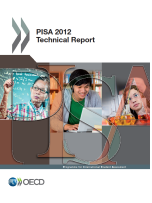PISA 2012 Technical report
 |
The PISA 2012 Technical Report describes the methodology underlying the PISA 2012 survey, which tested 15-year-olds’ competencies in mathematics, reading and science and, in some countries, problem solving and financial literacy. It examines the design and implementation of the project at a level of detail that allows researchers to understand and replicate the resulting data and analyses. The reader will find a wealth of information on the test and sample design, modes of delivery (paper-based or computer-based), methodologies used to analyse the data, technical features of the project, and quality control mechanisms. |
Related Documents

